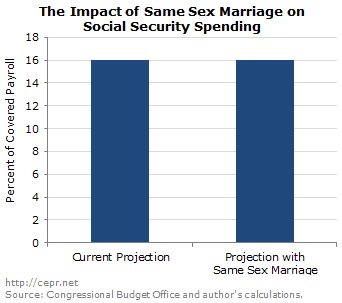June 26, 2013
While many are celebrating the Supreme Court’s decision granting marriage equality to same sex couples, some have been quick to highlight the potential budgetary costs of this decision. In particular, opponents of the court’s ruling are warning the public that it will lead to much higher costs for Social Security.
Before anyone rushes to push through a constitutional amendment, it would be worth trying to get an idea of the potential costs to Social Security resulting from this decision. Essentially the decision says that same sex couples have the right to be married and enjoy the same benefits and protection that Social Security provides to heterosexual couples.
There would be some issues involving children of spouses of disabled workers or workers who have an early death, but the bulk of the impact will be from spouses in same sex couples who will be entitled to a higher retirement benefit as a result of marriage. This takes two forms. First, in retirement a spouse is entitled to half of their married partner’s benefit if this would be larger than the benefit they would receive based on their own work history. Second, after a spouse dies, a retiree is entitled to the higher of either their own benefit or their spouses. By virtue of the fact that same sex couples will now be able to have the same rights in marriage as heterosexual couples, both of these channels will lead to higher benefit payouts.
Of course in the vast majority of cases, the wage-based benefit of the lower earning spouse will be more than half of the benefit of the higher earning spouse. The reason is that the benefit structure is very progressive. Suppose that a higher earning spouse had an average lifetime indexed-earnings of $100,000 in 2013 dollars.[1] Under the current benefit formula this worker would be entitled to $2,500 a month or $30,000 a year, if he or she waited until age 66 to start collecting benefits.
In order for a worker’s wages to qualify them for at least half of this benefit or $1,250 a month, they would need average earnings of just $29,750 a year (@ $15 an hour for a full-year worker), less than one-third of their high earning spouse’s wages. While there continue to be large gaps between male and female earnings, the gaps are likely to be smaller between the earnings of two men or two women in a same sex marriage. Therefore it is likely that in the case of most same sex couples, the lower earning spouse will have a wage-based benefit that is at least half as high as that of the higher earning spouse. In the cases where this is not true, the bump up to half of the spouses benefit is likely to be small.
Recognizing same sex marriages means that there will also be cases where a surviving spouse will be entitled to the higher of their wage-based benefit or their spouse’s. This will also mean somewhat higher payouts, but the additional cost will be limited for two reasons. First the gap in earnings-based benefits in same sex couples is likely to be smaller than for heterosexual couples. Second, the time-period that the survivor in a marriage outlives their spouse is likely to be relatively short.
In the case of heterosexual couples, women are typically two to three years younger than their husband and enjoy a longer life expectancy. According to a Congressional Budget Office (CBO) analysis, partners in same sex couples are typically the same age and of course do not have sex-based differences in life expectancy.[2]
Based on its analysis, CBO estimated that the additional cost to Social Security in 2014 from recognizing same-sex marriages in 2004 would be $350 million. This is approximate 0.04 percent of the $875 billion that program is projected to pay out next year. Even if we double this figure, under the assumption that there may be more same sex marriages through time if the practice gains social acceptance the cost would still only be 0.08 percent of projected spending.
To put this in the context of the program’s larger finances, Social Security’s spending over its 75—year planning period was projected at 16.03 percent of covered payroll.[3] If we double the estimated cost in the CBO projections, then the cost of the program will rise to 16.04 percent of payroll. In other words, the additional expenses associated with the recognition of same sex marriage would impose a burden on the program that could be met with an increase of 0.005 percent in both the worker and employer’s contribution to the program.

The Social Security benefit formula indexes a worker’s wages to average earnings in the economy for each year and then takes the average for their best 35 years.
Congressional Budget Office, 2004. “Letter to Representative Steve Chabot on the potential budgetary effects of recognizing same sex marriage,” Available at http://www.cbo.gov/sites/default/files/cbofiles/ftpdocs/55xx/doc5559/06-21-samesexmarriage.pdf
Social Security Trustees Report, 2013, Table IV.B4 http://www.socialsecurity.gov/OACT/TR/2013/IV_B_LRest.html#433140






